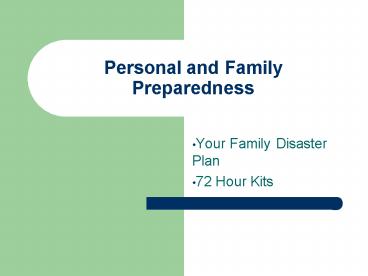Personal and Family Preparedness - PowerPoint PPT Presentation
1 / 18
Title:
Personal and Family Preparedness
Description:
Ask what types of disasters are most likely to happen and how to prepare for each. ... records, and other family records (birth, marriage, death, certificates) ... – PowerPoint PPT presentation
Number of Views:119
Avg rating:3.0/5.0
Title: Personal and Family Preparedness
1
Personal and Family Preparedness
- Your Family Disaster Plan
- 72 Hour Kits
2
Your Family Disaster Plan
- Contact your local emergency management office
and be prepared to take notes. - Ask what types of disasters are most likely to
happen and how to prepare for each. - Learn about community warning signals what they
sound like and what your should do if they sound
3
Your Family Disaster Plan
- Find out about disaster plans at work, your
childrens school, and other places where your
family spends time. - Discuss preparedness with your family.
- Explain the different types of disasters and what
to do in each case. Work together as a team to
prepare.
4
Your Family Disaster Plan
- Determine two escape routes from each room in
your home. - Pick two places to meet
- One right outside your home in case of a sudden
emergency, like a fire. - One outside your neighborhood in case you cant
return home. Everyone must know the address and
phone number.
5
Your Family Disaster Plan
- Ask an out-of-state friend to be you family
contact. After a disaster, it is often easer to
call long distance. Family members should call
this person and tell them where they are.
Everyone must know your family contact and phone
number. - Create a Disaster Supply Kit.
- Discuss what to do in an evacuation.
6
Your Family Disaster Plan
- Teach children how and when to call 911 and other
emergency numbers (fire, police, etc.) Post these
numbers near phones. - Show each responsible family member how and when
to turn off utilities at the main switches.
Remember to turn off utilities only if you
suspect the lines are damaged or are instructed
to do so. If you turn the gas off, professionals
will have to turn it back on.
7
Your Family Disaster Plan
- Show family members how to use a fire
extinguisher (ABC type) and where it is kept. - Install smoke detectors one each level of your
home, especially near bedrooms. - Conduct a home hazard hunt.
- Learn basic first aid skills, including CPR
- Make sure your insurance coverage is adequate.
8
72 Hour Kits
9
72 Hour Kits
10
72 Hour Kits
11
72 Hour Kits
12
72 Hour Kits first aid kit cont.
13
72 Hour Kits
14
72 Hour Kits tools continued
15
Preparing Your Disaster Supply Kit
- Place the supplies you would most likely need for
an evacuation in an easy-to-carry container such
as a backpack, duffel bag, or a clean covered
trash container. - Consider preparing a kit for your office and car
as well. - Store your kit in a convenient place.
- Keep items in airtight plastic bags.
- Ask your physician or pharmacist about storing
prescription medication.
16
Special Needs
- For Baby
- Formula or powdered milk
- Bottles
- Diapers and wipes.
17
Special Items
- For Children
- Enertainment items
- Games
- Books
- Toys
- Etc.
18
Special Needs
- For Adults
- Denture needs.
- Extra eye glasses or contact lenses and supplies
- Important documents kept in a waterproof,
portable container. - Will, insurance policies, contacts, deeds,
stocks, and bonds. - Passport, social security cards, immunization
records, and other family records (birth,
marriage, death, certificates). - Bank and credit card account numbers.
- Inventory of valuable household goods.
- Important telephone numbers.





























